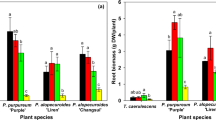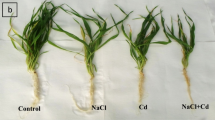Abstract
An ‘alternating solution’ culture method was used to study the effects of chloride ions and humic acid (HA) on the uptake of cadmium by barley plants. The plants were transferred periodically between a nutrient solution and a test solution containing one of four levels of HA (0, 190, 569 or 1710 μg cm−3) and one of five levels of Cd (0, 0.5, 1.0, 2.5 or 5.0 μg cm−3) in either a 0.006M NaNO3 or 0.006M NaCl medium. Harvest and analysis of shoots and roots was after nineteen days. The distribution of Cd in the test solutions between Cd2+, CdCl+ and HA-Cd was determined in a separate experiment by dialysis equilibrium.
In the nitrate test solutions Cd uptake was clearly controlled by Cd2+ concentration and was therefore reduced by HA complex formation. In the absence of HA, chloride suppressed Cd uptake indicating that Cd2+ was the preferred species. However complex formation with Cl− enhanced uptake when HA was present because of an increase in the concentration of inorganic Cd species relative to the nitrate system.
The ratio root-Cd/shoot-Cd remained at about 10 across a wide range of shoot-Cd concentrations, from about 3 μg g−1 (sub-toxic) up to 85 μg g−1 (80% yield reduction). The ability of the barley plants to accumulate ‘non-toxic’ Cd in their roots was thus very limited. Humic acid also had no effect on Cd translocation within the plant and the root/shoot weight ratio did not vary with any treatment.
At shoot-Cd concentrations in excess of 50 μg g−1, K, Ca, Cu and Zn uptake was reduced, probably the result of root damage rather than a specific ion antagonism. The highest concentration of HA also lowered Fe and Zn uptake and there was a toxic effect with increasing HA concentration at Cd=0. However the lowest HA level, comparable with concentrations found in mineral soil solutions, only reduced yield (in the absence of Cd) by <5% while lowering Cd uptake across the range of Cd concentrations by 66%–25%.
Similar content being viewed by others
References
Allen H E, Hall R H and Brisbin T D 1980 Metal speciation. Effects on aquatic toxicity. Environ. Sci. Technol. 14, 441–443.
Berrow M L and Webber J 1972 Trace elements in sewage sludges. J. Sci. Fd. Agric. 23, 93–100.
Bauchauer M J 1973 Contamination of soil and vegetation near a zinc smelter by zinc, cadmium, copper and lead. Environ. Sci. Technol. 7, 1331–135.
Cossa D 1976 Sorption of cadmium by a population of the diatomPhaeodactylum tricornutum in culture. Mar. Biol. 34, 163–167.
Davies B E and Roberts L J 1978 The distribution of heavy metal contaminated soils in northeast Clywd, Wales. Wat. Air Sol Pollut. 9, 507–518.
De Haan F A M and Zwerman P J 1976 Pollution of Soil. Chapter 10In Soil Chemistry A. Basic Elements. Eds. G H Bolt and M G M Bruggenwert, Elsevier.
Fernandez V H 1968 The action of humic acid of different sources on the development of plants and their effect on increasing concentration of the nutrient solution.In Study Week on Organic Matter and Soil Fertility. North Holland Publishing Co. Amsterdam.
Frankland B and Khan D H 1983 Effects of cadmium and lead on radish plants with particular reference to movements of metals through soil profile and plant. Plant and Soil 70, 335–345.
Friberg L, Piscator M and Nordberg G F 1971 Cadmium in the Environment. CRC Press, Cleveland, Ohio.
Gerritse R G, Van Driel W, Smilde K W and Van Luit B 1983 Uptake of heavy metals by crops in relation to their concentration in the soil solution. Plant and Soil 75, 393–404.
Grime J P and Hodgson J G 1968 An investigation of the ecological significance of lime chlorosis by means of large scale comparative experiments.In Ecological Aspects of the MineralNutrition of Plants. Ed. I H Rorison. British Ecological Society Symposium. Blackwell.
Hardiman R T, Jacoby B and Banin A 1984 Factors affecting the distribution of cadmium, copper and lead and their effect upon yield and zinc content in bush beans. Plant and Soil 81, 17–27.
Hewitt E J 1966 Sand and culture methods used in the study of plant nutrition, 2nd Edition. Technical communication No. 22. Commonwealth Agricultural Bureau. Commonwealth Bureau of Horticulture and Plantation Crops. Maidstone, England.
Jackson M L 1958 Soil Chemical Analysis. Prentice Hall Inc.
Jarris R A 1967 Soils of the Reading District. Soil Survey of England and Wales. Harpenden.
Laxen D P H 1982 The Chemistry of Metal Pollutants in Water. Chapter 6 of Pollution: Causes, Effects and Control. Ed. R M Harrison. Special Publication No. 44 of the Royal Society of Chemistry.
Macnicol R D and Beckett P H T 1985 Critical tissue concentrations of potentially toxic elements. Plant and Soil 85, 107–129.
Martin M H, Coughtrey P J, Shales S W and Little P 1980 Aspects of airborne cadmium contamination of soils and natural vegetation.In Inorganic Pollution and Agriculture, MAFF Reference Book 326.
Page A L 1981 Cadmium in soils and its accumulation by food crops.In Heavy Metals in the Environment; International Conference, Amsterdam, 206–213. CEP Consultants Ltd.
Petersen R 1982 Influence of copper and zinc on the growth of a freshwater alga,Scenedesmus quadricauda: the significance of chemical speciation. Environ. Sci. Technol. 16, 443–447.
Poapst P A, Genier C and Schnitzer M 1970 Effect of soil fulvic acid on stem elongation in peas. Plant and Soil 32, 367–372.
Schnitzer M and Khan S V 1972 Humic Substances in the Environment. Marcel Dekker, New York.
Sillén L G and Martel E A 1971 Stability Constants of Metal-Ion Complexes: Supplement No. 1. Chemical Society, London.
Thornton I 1980 Geochemical aspects of heavy metal pollution and agriculture in England and Wales.In Inorganic Pollution and Agriculture, MAFF Reference Book 326.
Tyler L D and McBride M B 1982 Influence of Ca, pH and humic acid on Cd uptake. Plant and Soil 64, 259–262.
Vaughan D 1974 A possible mechanism for humic acid action on cell elongation in root segments ofPisum sativum under aseptic conditions. Soil Biol. Biochem. 6, 241–247.
Young S D and Bache B W 1985 Aluminium-organic complexation: formation constants and a speciation model for the soil solution. J. Soil Sci. 36, 261–269.
Author information
Authors and Affiliations
Rights and permissions
About this article
Cite this article
Cabrera, D., Young, S.D. & Rowell, D.L. The toxicity of cadmium to barley plants as affected by complex formation with humic acid. Plant Soil 105, 195–204 (1988). https://doi.org/10.1007/BF02376783
Received:
Revised:
Issue Date:
DOI: https://doi.org/10.1007/BF02376783




